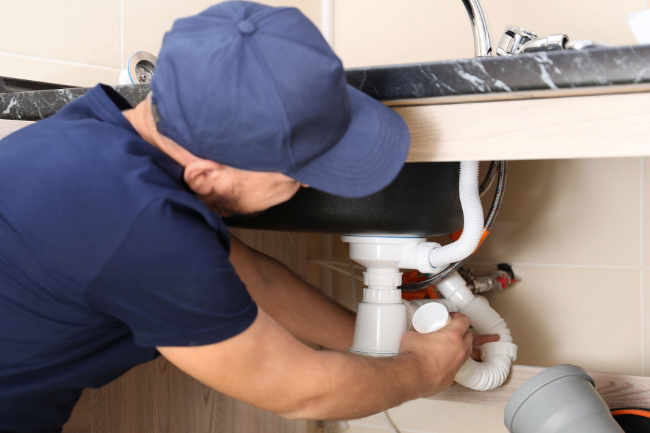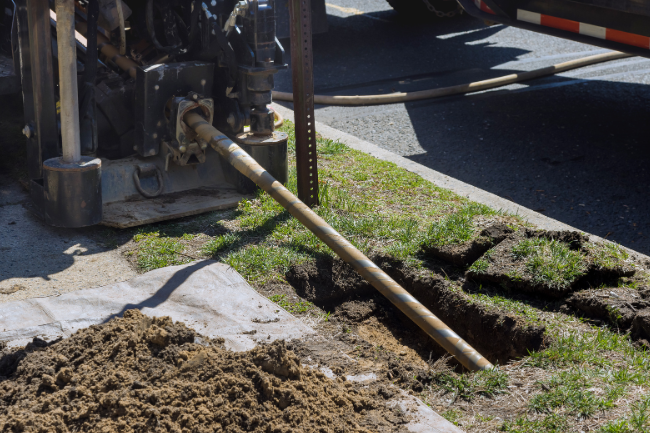Warning Signs of a Slab Leak (and How to Fix It)
Posted by William Heinselman on

Every now and again, leaks can occur in the home. It can happen to even the most diligent homeowner. Thankfully, many of the most common leaks occur in relatively easy-to-reach areas such as below a sink or in the shower or toilet. These leaks are easy to spot and can often be fixed with a few ordinary household plumbing tools.
What is a Slab Leak?
Unfortunately, some leaks can happen where they are hard to detect, let alone fix. When a pipe underneath a home's slab foundation has a leak, most homeowners may not notice they have a problem for a long time. The broken pipe allows water to seep into the ground and the home’s foundation. In addition to wasting water, the leak can damage the concrete and erode the soil around it. Over time, it may cause the foundation to buckle and shift, cracking the home’s floors and walls. In severe cases, it can even cause portions of the house to collapse.
How Common are Slab Leaks?
The frequency of slab leaks varies from region to region. They are particularly common in states like California that suffer from earthquakes because the shifting ground puts tremendous pressure on pipes, making them more likely to shear or crack. Older homes are also more vulnerable to slab leaks due to corroding copper pipes or deteriorating Orangeburg sewer pipes.
For many homeowners, water leaks in a slab foundation may go completely unnoticed until they get a utility bill with a much higher than normal water cost. After that, most homeowners will check all of the usual suspects in water leak issues, such as faucets, toilets, showers, and hoses in and around the home to see if they can locate the leak. The dreaded slab leak will often escape a homeowner's notice during and after this inspection process.
Warning Signs of a Slab Leak
If you suspect that you have a leak underneath your home's slab foundation, here are a few things that can help you locate the leak.
Warm Spots On the Floor
If the hot water line in your home is the one with the leak, then you may be able to find the location of the leak by checking for abnormally warm spots on your floor. If you have a carpeted floor, or really thin linoleum floors, this can be fairly easy. For a tile floor, this may be more difficult unless the leak is severe enough to cause water to flow into the space between the adhesive and the tiles. In such an instance you may have other warning signs for water damage in your tile flooring. Hardwood floors may also increase the difficulty of finding a warm spot in the floor.
Raised "Dome" In the Floor.
If a leak is severe enough and lasts for a while, you may notice damage to your flooring in the form of warps in the shape of the floor. A common phenomenon in severe water damage is the formation of a "dome," or raised area in the floor. While the presence of a dome in your floor can give you a good indication of the leak's location, it also means that there is severe damage occurring to your home's foundation.
Foundation Heaving
If your foundation slab experiences swelling to an extreme degree, it can actually lift the building slightly. This occurrence is called heaving. If your home has undergone heaving because of a leak underneath the slab foundation, it is critical that you seek expert assistance in the repair.
If a sudden, significant shift occurs in the building's foundation, it can cause severe, sometimes irreparable damage to the home. This damage can manifest as cracks on the interior and exterior walls as well as the slab itself. As settling in the building’s foundation can also cause these signs of damage, it is important to consult an experienced repair technician who can identify the differences.
Water Bill Increase
If your water bill experiences a sudden spike without an increase in the basic cost of service or use of water by your family, that can often be an early indication that you have a severe leak.
Slab Leak Detection Equipment
If you cannot locate a leak through the above methods, it may be worth investing in specialized equipment to detect a leak. Professional plumbers will often drain the water from a building's water lines and then pump in air to identify leaks. The plumber will usually employ special sound equipment to aid in detecting the precise location of a leak.
In most cases, the average cost of detecting a slab leak is between $150 and $400. While it is recommended that you employ an experienced plumbing professional, it is possible to obtain the equipment for detecting the leak yourself.
How to Fix a Slab Leak
Now that you have located your slab leak, how do you go about repairing the problem? For the average person, this process is going to be a difficult, messy, and often costly endeavor. It is HIGHLY recommended that you seek out the services of a professional plumbing service as a variety of complications could arise during the repair that the average DIY homeowner isn’t equipped to handle.
Be Sure About the Leak’s Location
Before you even consider ripping up your concrete slab, you have to be absolutely sure about the location of your slab leak. If you are the least bit uncertain, do not start destroying your home in an attempt to fix the leak. It’s important to be absolutely sure of the leak's location before you begin breaking up your floor.
Prepare for Hazardous Conditions
Before starting to rip up your floor, make sure you have cleared the room of any furnishings. This means relocating any furniture, paintings, rugs, electronics, and valuables from the room. There is going to be an abundance of dust particles floating throughout the room during this process, so the best protection you can give your possessions is to remove them from the room where you will be making repairs.
You should also wear protective gear including gloves, goggles, a breathing mask, heavy-duty clothes, and steel-toe boots. If possible, it’s best to have a second person providing assistance who also has safety gear.
Use the Right Equipment
If you have access to a jackhammer, you will want to use this tool to aid you in reaching the area underneath the slab so you can perform the repair. However, if you lack experience and training in the use of this incredibly dangerous heavy-duty power tool, do not attempt to use it. In the hands of an untrained operator, a jackhammer can cause serious bodily harm to the operator and innocent bystanders. Also, you can end up causing unnecessary extra damage to your home's foundation or the pipes during slab foundation excavation. So, it’s important to seek expert assistance in the excavation process.
If you successfully excavate your under-the-slab pipes and can identify the source of the leak, you can then begin to repair the leak. If, however, the leak is from a sewage line, you will want to contact a professional service to deal with the potentially biologically-hazardous waste products involved in sewage disposal and repair.
Calling For Backup
If you need further advice about how to detect, service, and clean up after a major leak in your home, do not hesitate to contact a plumbing expert for assistance. In almost every case, it’s better to entrust the job to a professional from the beginning. At Express Sewer & Drain, we have years of experience with home plumbing issues like slab leaks in the Sacramento area. Fully-licensed and insured, our team of professionals is dedicated to providing outstanding service to our customers whether we’re clearing a clogged sink or replacing a sewer line beneath your home’s foundation. Contact us today for a free estimate.
Topics: Trenchless Technology, Pipe Leaks and Repair, Home Plumbing


![Repiping Your Sacramento Home [6 Steps]](https://www.expresssewer.com/hs-fs/hubfs/plumbing%20tools%20and%20blueprints.jpeg?width=550)




